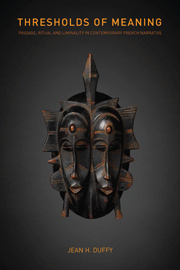Book contents
- Frontmatter
- Contents
- Acknowledgements
- List of illustrations
- Introduction
- 1 At death's door: illness, ritual and liminality in Darrieussecq, Lenoir, and Mauvignier
- 2 Suicide and saving face in Bon, Mauvignier and Bergounioux
- 3 Commemoration, monument and identity in Bergounioux, Darrieussecq and Rouaud
- 4 Retouching the past: family photographs and documents in Rouaud, Bon and Lenoir
- Conclusion: Writing passage and the passage to writing
- Notes
- Select bibliography
- Index
Introduction
- Frontmatter
- Contents
- Acknowledgements
- List of illustrations
- Introduction
- 1 At death's door: illness, ritual and liminality in Darrieussecq, Lenoir, and Mauvignier
- 2 Suicide and saving face in Bon, Mauvignier and Bergounioux
- 3 Commemoration, monument and identity in Bergounioux, Darrieussecq and Rouaud
- 4 Retouching the past: family photographs and documents in Rouaud, Bon and Lenoir
- Conclusion: Writing passage and the passage to writing
- Notes
- Select bibliography
- Index
Summary
Doomsayers and boomsayers: the critical context
Over the last thirty years or so, critics and cultural commentators in France and elsewhere have regularly – often with irritation, sometimes with gloomy defeatism and occasionally with a touch of Schadenfreude – drawn attention to what they believe to be the current ‘crisis’ or even decline of the French novel. These comments are, of course, part of a much more general context in which France has seen its cultural influence in the world undermined by among other factors: competition from the New York and London art markets, the impact of American cinema on French box-office receipts, the popularity of translations of English-language novels in France, the reduction in the number of translations of French texts published each year, and the fluctuating fortunes of Modern Languages in the secondary and university sector in the US and Europe. As France's authority and influence have apparently receded, the arts pages of newspapers and magazines have offered their readers frequent reminders of its supposedly ailing culture.
The stridency and repetitiveness of the décliniste alarms sounded over the last three decades are explained partly by the stress placed by French cultural history on linearity and its conception of literature and art in terms of a succession of movements (Taylor, 1996, 143).
- Type
- Chapter
- Information
- Thresholds of MeaningPassage, Ritual and Liminality in Contemporary French Narrative, pp. 1 - 28Publisher: Liverpool University PressPrint publication year: 2011
- 1
- Cited by

